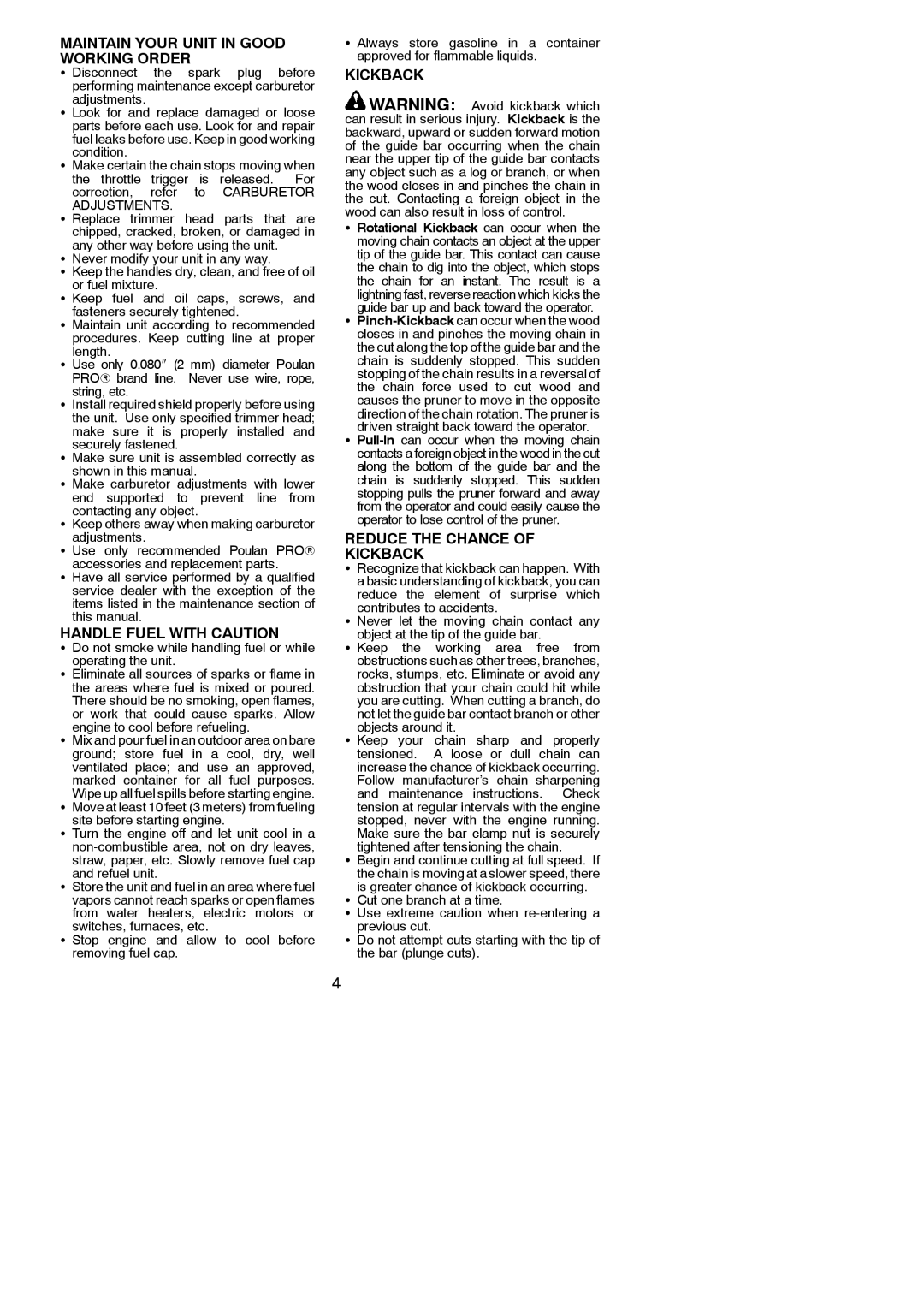MAINTAIN YOUR UNIT IN GOOD WORKING ORDER
S Disconnect the spark plug before performing maintenance except carburetor adjustments.
S Look for and replace damaged or loose parts before each use. Look for and repair fuel leaks before use. Keep in good working condition.
SMake certain the chain stops moving when the throttle trigger is released. For
correction, refer to CARBURETOR ADJUSTMENTS.
S Replace trimmer head parts that are chipped, cracked, broken, or damaged in any other way before using the unit.
SNever modify your unit in any way.
SKeep the handles dry, clean, and free of oil or fuel mixture.
S Keep fuel and oil caps, screws, and fasteners securely tightened.
S Maintain unit according to recommended procedures. Keep cutting line at proper length.
S Use only 0.080″ (2 mm) diameter Poulan PRO→ brand line. Never use wire, rope, string, etc.
SInstall required shield properly before using the unit. Use only specified trimmer head;
make sure it is properly installed and securely fastened.
SMake sure unit is assembled correctly as
shown in this manual.
S Make carburetor adjustments with lower end supported to prevent line from contacting any object.
SKeep others away when making carburetor adjustments.
S Use only recommended Poulan PRO→ accessories and replacement parts.
SHave all service performed by a qualified service dealer with the exception of the items listed in the maintenance section of this manual.
HANDLE FUEL WITH CAUTION
SDo not smoke while handling fuel or while
operating the unit.
SEliminate all sources of sparks or flame in the areas where fuel is mixed or poured. There should be no smoking, open flames,
or work that could cause sparks. Allow engine to cool before refueling.
SMix and pour fuel in an outdoor area on bare
ground; store fuel in a cool, dry, well ventilated place; and use an approved, marked container for all fuel purposes. Wipe up all fuel spills before starting engine.
SMove at least 10 feet (3 meters) from fueling
site before starting engine.
S Turn the engine off and let unit cool in a
SStore the unit and fuel in an area where fuel vapors cannot reach sparks or open flames from water heaters, electric motors or switches, furnaces, etc.
S Stop engine and allow to cool before removing fuel cap.
S Always store gasoline in a container approved for flammable liquids.
KICKBACK
![]() WARNING: Avoid kickback which can result in serious injury. Kickback is the backward, upward or sudden forward motion of the guide bar occurring when the chain near the upper tip of the guide bar contacts any object such as a log or branch, or when the wood closes in and pinches the chain in the cut. Contacting a foreign object in the wood can also result in loss of control.
WARNING: Avoid kickback which can result in serious injury. Kickback is the backward, upward or sudden forward motion of the guide bar occurring when the chain near the upper tip of the guide bar contacts any object such as a log or branch, or when the wood closes in and pinches the chain in the cut. Contacting a foreign object in the wood can also result in loss of control.
S Rotational Kickback can occur when the moving chain contacts an object at the upper tip of the guide bar. This contact can cause the chain to dig into the object, which stops the chain for an instant. The result is a lightning fast, reverse reaction which kicks the guide bar up and back toward the operator.
S
driven straight back toward the operator. S
contacts a foreign object in the wood in the cut along the bottom of the guide bar and the chain is suddenly stopped. This sudden stopping pulls the pruner forward and away from the operator and could easily cause the operator to lose control of the pruner.
REDUCE THE CHANCE OF
KICKBACK
SRecognize that kickback can happen. With a basic understanding of kickback, you can reduce the element of surprise which contributes to accidents.
S Never let the moving chain contact any object at the tip of the guide bar.
S Keep the working area free from obstructions such as other trees, branches, rocks, stumps, etc. Eliminate or avoid any obstruction that your chain could hit while you are cutting. When cutting a branch, do not let the guide bar contact branch or other objects around it.
S Keep your chain sharp and properly tensioned. A loose or dull chain can increase the chance of kickback occurring. Follow manufacturer’s chain sharpening and maintenance instructions. Check tension at regular intervals with the engine stopped, never with the engine running. Make sure the bar clamp nut is securely tightened after tensioning the chain.
SBegin and continue cutting at full speed. If
the chain is moving at a slower speed, there is greater chance of kickback occurring.
SCut one branch at a time.
S Use extreme caution when
SDo not attempt cuts starting with the tip of the bar (plunge cuts).
4
